(单词翻译:单击)
With 4,826 confirmed planets and Kepler candidates and the discovery of a gas giant with a colossal system of 160 rings, it may seem like we know quite a bit about what is out there in the cosmos. However, the universe loves to confuse us, and—frankly—humanity has yet to come to grips with what is in our own solar system.
这些年来,我们已证实了4826颗行星以及开普勒候选行星的存在,还发现了一个有着160个外环的气体巨星系统,这似乎意味着我们对外太空了解颇多。然而事与愿违,宇宙如此浩瀚无边,让我们困惑不已,事实上我们甚至连自身所处的太阳系都了解不多。
10.Orcus And Vanth
10.奥库斯和万斯
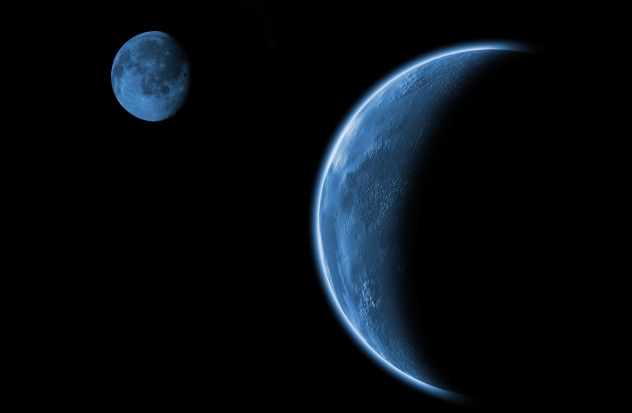
We have all heard about Pluto, especially after its declassification as a planet in 2006 and its coverage in the news due to the upcoming New Horizons probe flyby. But have you ever heard of what is sometimes referred to as "anti-Pluto"? 90482 Orcus is a Kuiper belt object with almost exactly the same orbital period, inclination, and distance from the Sun as Pluto.
我们一定都听过冥王星的大名,2006年其从行星行列中被剔除。随后新视野号对其进行了近地探测,探测报告见诸各大新闻版面,如此种种更是让其声名大噪。但你是否听说过"反冥王星"?奥库斯星属于库伯带天体,拥有和冥王星几乎相同的公转周期、倾斜角和距离。
Both Pluto and Orcus also share a 2:3 resonance with Neptune, although Orcus is oriented differently. Not only are their orbits almost identical, but they both have moons that are very large relative to their size. Pluto's moon Charon is half the size of Pluto, and Vanth has been estimated to be one-third the size of Orcus. The name "Orcus" was chosen because it's the Etruscan equivalent for the Roman "Pluto."The surface of Orcus is covered with crystalline water ice and, possibly, ammonia ice, which indicates that some sort of geological activity and cryovolcanism may have taken place in the past. If the presence of ammonia is confirmed, Orcus could help scientists understand the formation of other trans-Neptunian objects.
尽管奥库斯星的运行方向与冥王星不同,却共享一个比例为2:3的共振。它们不仅运行轨道几乎重合,还都拥有与其体积关联非常密切的卫星。冥王星的卡伦卫星的体积是冥王星的一半;而万斯卫星的体积则是奥库斯星的1/3。"Orcus"在伊特拉斯坎语中相当于罗马语中的"Pluto",二者都是"冥王"的意思,这也是这颗卫星名字的由来。奥库斯星的表面覆盖着透明的固态水和固态氨,表明这里曾发生过一系列地质和冰火山活动。如果氨的存在被证实,奥库斯星便可帮助科学家更好地了解外海王星体的构成。
9.90 Antiope
9.休神星
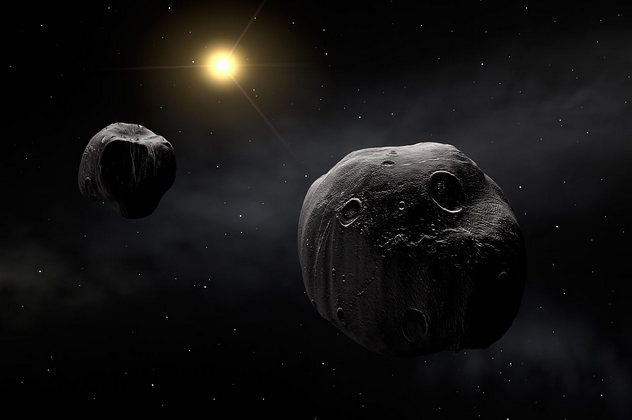
The number in 90 Antiope's name signifies that it was the 90th asteroid discovered, although that is actually a matter for debate. You see, this rare find, orbiting within the asteroid belt between Jupiter and Mars, is a binary system (also known as a "double asteroid"). So Antiope is technically the 90th and 91st asteroid discovered.
这个名字前面的数字表示这是第90颗被发现的小行星,尽管这广受争议。这颗卫星运行在在木星和火星间的小行星带中,是一颗罕见的双重小行星(也叫对等小行星)。所以严格来说它应该是第90到第91个被发现的小行星。
When it was first discovered, Antiope was cast aside, considered to be no different from countless other small objects orbiting within the asteroid belt. However, in 2000, the 10-meter (33 ft), ground-based telescope "Keck II" in Hawaii observed that the large singular blob seen by older telescopes was actually two smaller bodies orbiting each other. Each of them is approximately 86 kilometers (53 mi) in diameter, and their centers are separated by a distance of only 171 kilometers (101 mi).It is not uncommon for two objects to orbit each other to some degree, but since the difference in mass of each component of Antiope is so small, the best way to imagine what it looks like is to think of two spinning bowling balls held together by piece of string.
刚被发现的时候,休神星是被排除在行星序列之外的,因为人们觉得它和行星带里漂浮的宇宙尘埃并无本质区别,人们根本不会将其当做一颗行星来看待。然而在2000年,位于夏威夷的长达10米(33英寸)的凯克二号地面望远镜观测到,其他望远镜之前观测到的那个大星团,实际上是两颗相互运行的小星体。每个星体直径大约是86千米(53英里),它们之间的距离仅为171千米(101 英里)。两个天体相互运行并不罕见,但难得的是这两颗小行星的质量相差非常小。我们可以把它们想象成绑在同一根绳子上旋转的两颗保龄球。
8.Saturn's Hexagon
8.土星的六边风暴
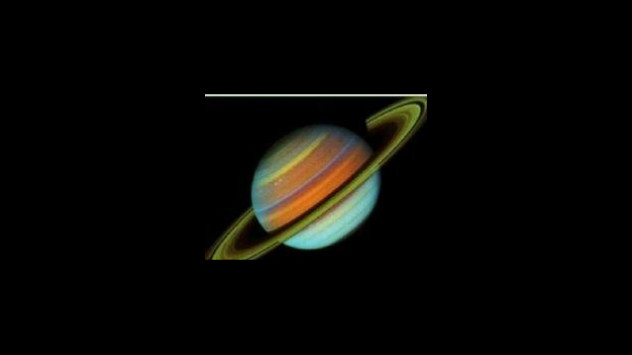
We all know about Saturn and its rings, but have you ever heard about its cloud patterns? In the early 1980s, the Voyager mission made a surprising and unprecedented discovery, which was confirmed by a visit from the Cassini spacecraft. Encompassing all of Saturn's north pole is a giant hexagonal storm with sides longer than the diameter of Earth. The storm has been raging for over 30 years. Spookily, the hexagon doesn't move with the rest of the clouds on the planet, and since it possesses such a large degree of geometric precision, countless conspiracy theories have sprung up about it. (Thankfully, most of them are not serious.)
我们对土星和它的外环都有所了解,但是你们听说过它的云腾吗?上世纪80年代初,"航行者号"取得一个惊人的新发现,这一发现随后又被卡西尼号飞船证实:一个边长超过地球直径的巨型六边形风暴笼罩在土星的北半球上。这一风暴已在此肆虐超过30年。诡异的是,这个六边形风暴并不像云一样移动,而且它的几何形状非常精准,因而数不尽的阴谋论像雨后春笋般涌现。——值得庆幸的是,它们大多数都不是真的。
While the phenomenon is still not fully explained, scientists have several ideas that help explain exactly what is going on using "fluid dynamics." Lab experiments have shown that in a fluid where the center is spinning faster than the outer sides, turbulence starts to create edges. At high enough speeds, polygon shapes begin to appear. Since the winds in the hexagon have been clocked at 322 kilometres per hour (200 mph), crisp sides have formed. While this sounds like a pretty solid theory, some are still convinced that it is, of course, an opening to another dimension.
虽然这个现象的成因还没有完全弄清楚,科学家们还是利用流体动力学解释了这一现象。实验研究表明,当风暴中心的旋转速度比气外围快时,风暴就会开始形成边缘;当速度足够快时,就会逐渐呈现出多边形态。六边形风暴的时速达每小时322千米(200英里),所以就形成了新的形状。这听起来似乎挺有道理,但依然有人相信还有更好的解释。
7.Haumea
7.妊神星
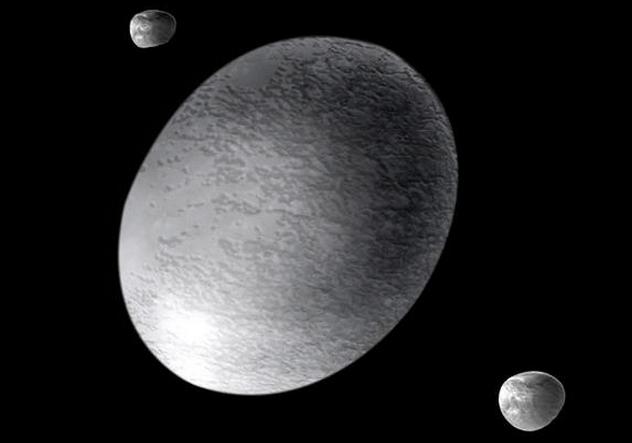
Before it was officially named, 136108 Haumea was known as "Santa," due to being discovered on December 28, 2004. This is actually rather fitting, since Haumea is a rather "gifted" and unique dwarf planet. Scientists initially found it hard to take measurements of Haumea because of its extremely rapid rotation, faster than any other known body in the solar system—a day is only 3.9 hours long.
因妊神星于2004年12月28日被发现,在正式命名前它曾被叫作"圣诞老人"。其实这十分贴切,因为它的确是一颗非常独特的矮行星。它的公转速度比太阳系中其他已知星体都要快,妊神星上的一天按照我们的计时标准只有3.9个小时,所以在开始的一段时间内,科学家们很难对它进行测量。
The rotation itself would not cause too many problems, but Haumea is not shaped like any other planet. Due to its composition of rock and ice and its very low gravity holding it together, the immense centrifugal force has stretched the surface into what is known as a "scalene ellipsoid." This means that the distance between its poles is 996 kilometers (619 mi), but its longest axis is a whopping 1,960 kilometers (1,218 mi) across.Not only does Haumea possess some of the most interesting rotational properties, it also has two moons, Hi'iaka and Namaka. Not bad for something with only 6 percent the mass of our moon.
妊神星的自转并不是问题,但它和其他星球形状不同。这是因为妊神星上的岩石和冰仅靠十分弱小的的地心引力维系在一起,但巨大的离心力却将星体表面拉伸为"不规则椭圆体"。正因如此,它两极之间的距离仅为996千米(619英里),而其最长轴却有1960千米(1218英里)。妊神星不仅自转特性非常有趣,还有两颗卫星相随,即 妊卫一和 妊卫二。这对一个质量仅是月球质量6%的矮行星来说已是相当可观。
6.Pan And Atlas
6.潘恩和阿特拉斯
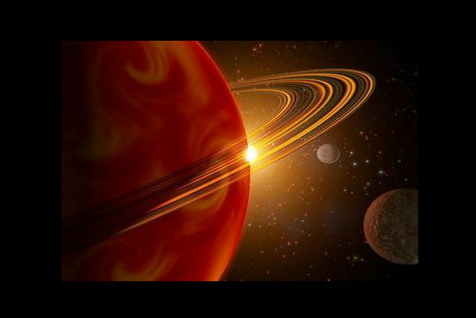
These two moons of Saturn have a lot in common and are the two closest moons to their parent body. What makes these two so special is the fact that they seem to have copied the rings of Saturn themselves, taking on a form that is straight out of a 1950s UFO B movie. Pan, being what is known as a "shepherd moon," got its name from the god of shepherds, while Atlas was named after the titan who "held the sky on his shoulders," since it supports the rings of Saturn.
这两颗卫星有许多相同之处,也是它们的母体——土星系统里相距最近的两颗卫星。它们的特殊之处在于拥有和土星外环一样的环带,20世纪50年代美国的一部UFO电影就曾以此作为素材。潘恩也叫"牧羊人卫星",得名于"牧羊之神"。阿特拉斯得名于"双肩顶天"的太阳神提坦,这是因为它看起来像是在支撑土星的外环。
Atlas, the flatter of the two, is only 19 kilometers (12 mi) from pole to pole but 46 kilometers (29 mi) across its waist. The elongated equators of these moons cannot be explained in the same way as Haumea, since they do not spin fast enough to bulge. Rapid rotation also creates a uniform elongation, and these moons are definitely not regular. It turns out that after many computer simulations, the University of Paris has found the answer: accretion disks. As a disk of debris spins, edges of the structure flatten out. During the formation of Saturn's moons, accretion disks made of dust from Saturn's rings formed around the tiny moons and eventually accumulated on their equators, creating their vast, bulging ridges.
阿特拉斯较为扁平,两极之间的距离仅为19千米(12英里),直径却长达46千米(29英里)。当然,这两颗卫星的赤道长度自然不能同妊神星相提并论,毕竟它们的自转速度并不足以使其膨胀。虽然它们也能自转形成一道狭长带,但这绝不会规律性出现。。巴黎大学在进行多次电脑模拟后终于找到了问题的答案:吸积盘的存在。当一盘太空碎片旋转时,结构的边缘就会变平。在土星形成卫星时,由土星环灰尘形成的吸积盘围绕在这些小卫星周围,并最终在赤道集合,形成巨大膨胀的赤道脊。
审校:哈利 来源:前十网


